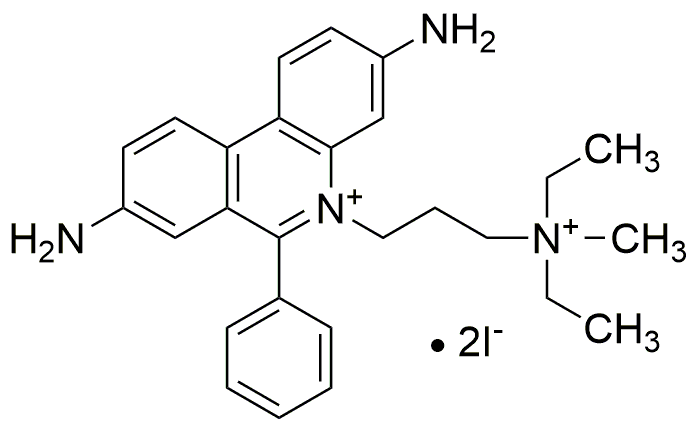Propidium iodide solution (1.0 mg/ml in water) is widely utilized in research focused on:
- Cell Viability Assays: This compound is commonly used to assess cell membrane integrity in various cell types, helping researchers determine the viability of cells in response to treatments or stress.
- Flow Cytometry: Propidium iodide is a vital tool in flow cytometry for staining DNA in cells, allowing for the analysis of cell cycle phases and apoptosis in a high-throughput manner.
- Fluorescence Microscopy: Its fluorescent properties make it ideal for visualizing dead cells in tissue samples, providing insights into cellular health and disease progression.
- Gene Delivery Studies: Researchers use this solution to evaluate the efficiency of gene delivery systems by distinguishing between successfully transfected and non-transfected cells.
- Pharmaceutical Development: In drug development, it helps in screening compounds for cytotoxicity, ensuring that new drugs are safe for human use by evaluating their effects on cell survival.
General Information
Properties
Safety and Regulations
Applications
Propidium iodide solution (1.0 mg/ml in water) is widely utilized in research focused on:
- Cell Viability Assays: This compound is commonly used to assess cell membrane integrity in various cell types, helping researchers determine the viability of cells in response to treatments or stress.
- Flow Cytometry: Propidium iodide is a vital tool in flow cytometry for staining DNA in cells, allowing for the analysis of cell cycle phases and apoptosis in a high-throughput manner.
- Fluorescence Microscopy: Its fluorescent properties make it ideal for visualizing dead cells in tissue samples, providing insights into cellular health and disease progression.
- Gene Delivery Studies: Researchers use this solution to evaluate the efficiency of gene delivery systems by distinguishing between successfully transfected and non-transfected cells.
- Pharmaceutical Development: In drug development, it helps in screening compounds for cytotoxicity, ensuring that new drugs are safe for human use by evaluating their effects on cell survival.
Documents
Safety Data Sheets (SDS)
The SDS provides comprehensive safety information on handling, storage, and disposal of the product.
Product Specification (PS)
The PS provides a comprehensive breakdown of the product’s properties, including chemical composition, physical state, purity, and storage requirements. It also details acceptable quality ranges and the product's intended applications.
Certificates of Analysis (COA)
Search for Certificates of Analysis (COA) by entering the products Lot Number. Lot and Batch Numbers can be found on a product’s label following the words ‘Lot’ or ‘Batch’.
*Catalog Number
*Lot Number
Certificates Of Origin (COO)
This COO confirms the country where the product was manufactured, and also details the materials and components used in it and whether it is derived from natural, synthetic, or other specific sources. This certificate may be required for customs, trade, and regulatory compliance.
*Catalog Number
*Lot Number
Safety Data Sheets (SDS)
The SDS provides comprehensive safety information on handling, storage, and disposal of the product.
DownloadProduct Specification (PS)
The PS provides a comprehensive breakdown of the product’s properties, including chemical composition, physical state, purity, and storage requirements. It also details acceptable quality ranges and the product's intended applications.
DownloadCertificates of Analysis (COA)
Search for Certificates of Analysis (COA) by entering the products Lot Number. Lot and Batch Numbers can be found on a product’s label following the words ‘Lot’ or ‘Batch’.
*Catalog Number
*Lot Number
Certificates Of Origin (COO)
This COO confirms the country where the product was manufactured, and also details the materials and components used in it and whether it is derived from natural, synthetic, or other specific sources. This certificate may be required for customs, trade, and regulatory compliance.


